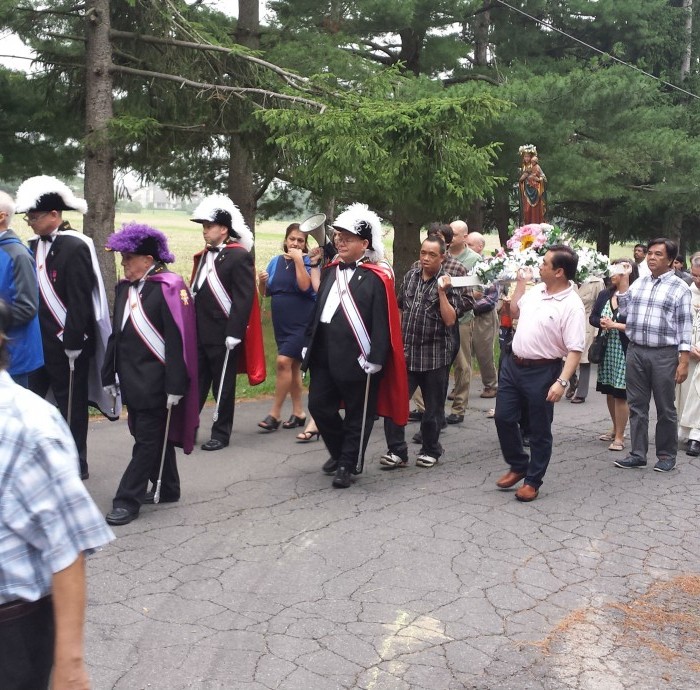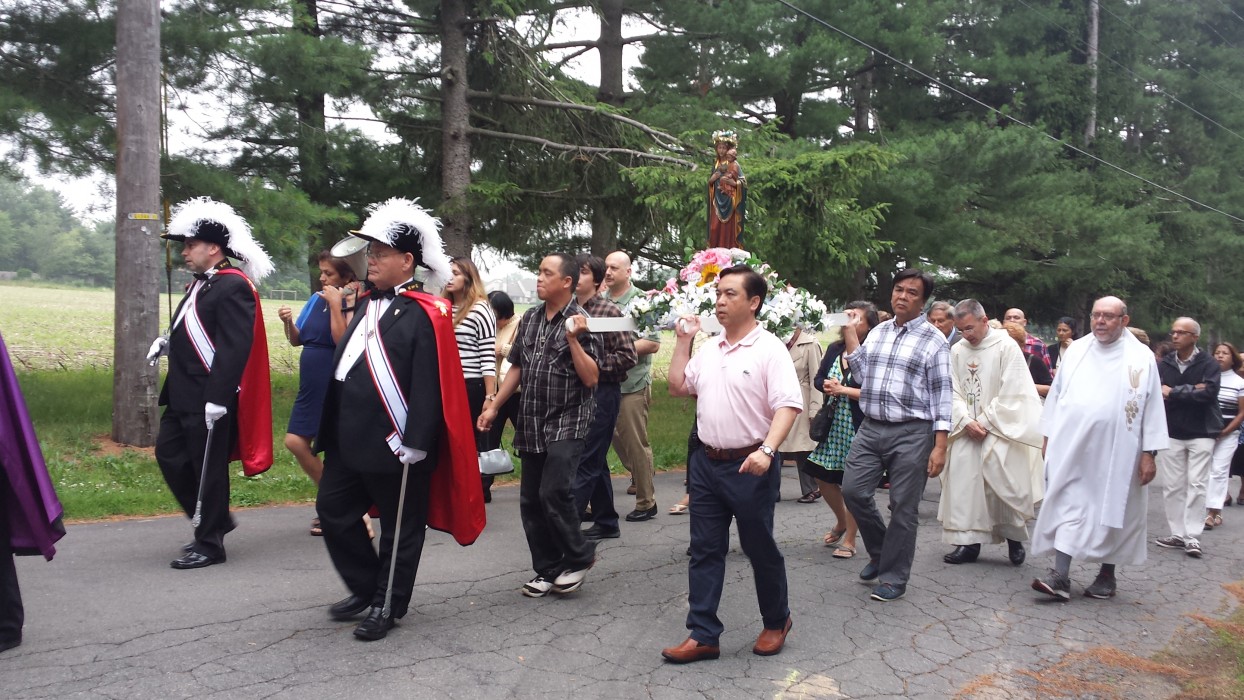Our Community in Somerset, following the tradition of Our Institute all over the world, celebrated lively the Consolata Feast on July 20 of this year. First, we asked the neighboring parishes that we serve to put an announcement in their weekly bulletin. We also made the announcement in the Masses that we celebrate at our Mission Center and in the parishes. Then we informed the people that we would have Mass at 5:30 pm, followed by an outdoor procession around our premises, and concluding with a potluck dinner at 7:00 pm. (In a potluck dinner, everyone brings some food to share with the others.)

No sooner had we made the first announcement than the people spread the news all over, one to another, like water flowing from an insignificant spring, slowly but steadily permeating the land and crops in its neighborhood, causing a green attractive environment all over. Within a short time, everyone was asking us how we were organizing the feast, how they could help, what they could bring, and other such questions. It was reminiscent of the people who, after Peter’s speech at Pentecost, asked him, “What are we to do?” (Acts 2: 37)
The organizing committee spontaneously formed itself, comprised of our collaborators in the Mission Center. These lovely women, fondly known as “the girls” – Kathy, Linda, Louise Land, and Lois Stridiron-Harris – were helped initially by a group of Filipinos and later by a group of Latinos.
People responded positively and generously. They came in large crowds with family and friends. It was a community of communities coming from different cultural origins and traditions but all forming the same Church, the same America, and the same humanity. An authentic re-encounter of cultures and traditions, it depicted the universality of the Consolata Missionaries and the Church. It was a feast in solidarity with the Consolata men and women all over the globe carrying out the mission according to the mandate of Jesus and Joseph Allamano. At the same time, we were accompanied by the spirit of Sr Irene Stefan who was beatified in Kenya a month before.
As Jesus was able to accommodate feeding the multitude by obtaining two fish and five barley loaves, so we were able to accommodate seating the crowd by holding the Mass in our Mission Center Hall instead of the chapel. Since it was spring in North America, it would have been better to celebrate in open space and make people sit on the grass like Jesus did, but unfortunately, the forecasters had predicted rain. However, the weather that day proved to be the best in weeks. It was neither hot nor cold, neither sunny nor rainy, but somewhere in between. Nor was there a need for any air conditioning apparatus. Although it had drizzled all afternoon, at exactly the start of Mass – the rain stopped. For the faithful, it was an “expected surprise” that occurs every June 20. They say that Our Lady never wants her children to get wet during her feast!
Fr Paolo Fedrigoni, coordinator of the US group, presided at the Mass, which was concelebrated by Fr Paul Stefanowich, Fr Timothy Kinywa, Fr Jean Paré (from Canada) and Fr Peter Ssekajugo. Fr. Paul, who had just been discharged from St. Peter’s hospital to a nursing home, came to celebrate with us.
In his homily, Fr Paolo explained the symbolism of the image of Our Lady Consolata. He commented on how the icon admirably reveals the identity of Jesus and Mary as well as their mutual relationship both on the human and faith levels.
Was it the last Consolata Feast in Somerset, New Jersey?
A particular expression was noticed on people’s faces and a certain feeling read from their hearts. This sentiment was gradually translated into one the most complicated questions for us to answer: “Is this really the last Mass the Consolata are celebrating in this Mission Center?” It was a simple and prudent way of asking: “Are you Consolata Missionaries really leaving us?” But who of us could give the correct, clear-cut, and good-to-hear answer? In other words, who of us could give the people the most consoling “respuesta”? We decided not to venture into responding with a “yes” or “no” answer or the more convenient, “We are still discerning,” “We don’t know yet,” or “Nothing has been decided yet.” All the same, many people could be heard lamenting our possible departure not from New Jersey but from the place (house) where we live now.

After Mass we had a long and multitudinous procession around the Consolata premises. A procession generally goes out of the liturgical routine and rigidness and allows people to socialize with one another more freely and to practice their popular religiosity and spirituality, enriching the event with cultural identity and diversity. Making a procession also contributes to a sense of a pilgrim people, the church on the move. It is not only a movement from earth to heaven but also a journey from the center to the periphery, from the temple to the villages, suburbs, and slums. It is a church in exodus, comprised of the people of the place, the immigrants, the poor, and all those excluded by the system. A procession is not only “liturgical” but also sociological, anthropological, and pastoral by which the church symbolizes its outreach to all. Within the temple we feel secure, strong, firm, and comfortable. When we go out, it is like “passing to the other bank” of the river with Jesus to feel the uncertainty of the outside and uncomfortableness of standing and walking. This is: la Iglesia en salida, “the Church on the move” of Francisco, who prefers an accidental Church doing mission to a Church that falls sick because of lack of movement.
As we processed around the compound carrying the statue of Mary, passing through the trees, singing and praying the rosary, we were grateful to share in the natural environment. Hearing the birds singing with us and experiencing the movement of the trees, we formed a communion between human beings and creation praising the Lord saying, “Laudato Si.” We are really all interconnected as the indigenous traditions and culture teach us, a teaching that Pope Francis has also reaffirmed in his new encyclical.
The statue of Our Lady was tied securely to a stretcher and carried by four people in a style similar to that of the Israelis carrying the tent of the ark during the exodus. We are a people that go all over the world with our Mother, taking the consolation that Jesus gives, the joy of the Gospel, the Word of God made flesh of humanity, beginning with the neediest.
From the Eucharistic Table to Dinner Table (primero la mistica despues la mastica).
After the procession we had dinner, a meal of meals, a catholic table, comprised of the various tastes of typical foods. People prepared Filipino food, African-Caribbean food, Italian pasta, American steak, Latino arroz con pollo. There were tastes, likes, and abundance for every person and group of persons. All the participants ate to their fill and whoever wanted to take some food home did so.
The feast ended at around 3:00 am. We thanked the people who collaborated in the organization of the Consolata Feast. May the Lord Jesus, through the intercession of our Lady of Consolation, console his people.
By Fr. Peter Ssekajugo, Somerset, New Jersey
